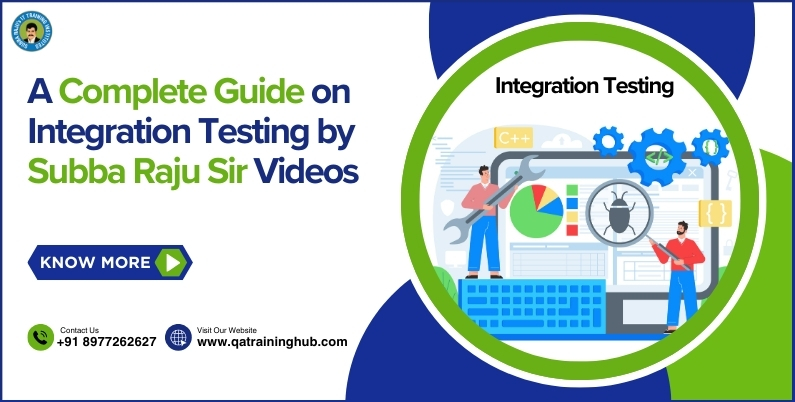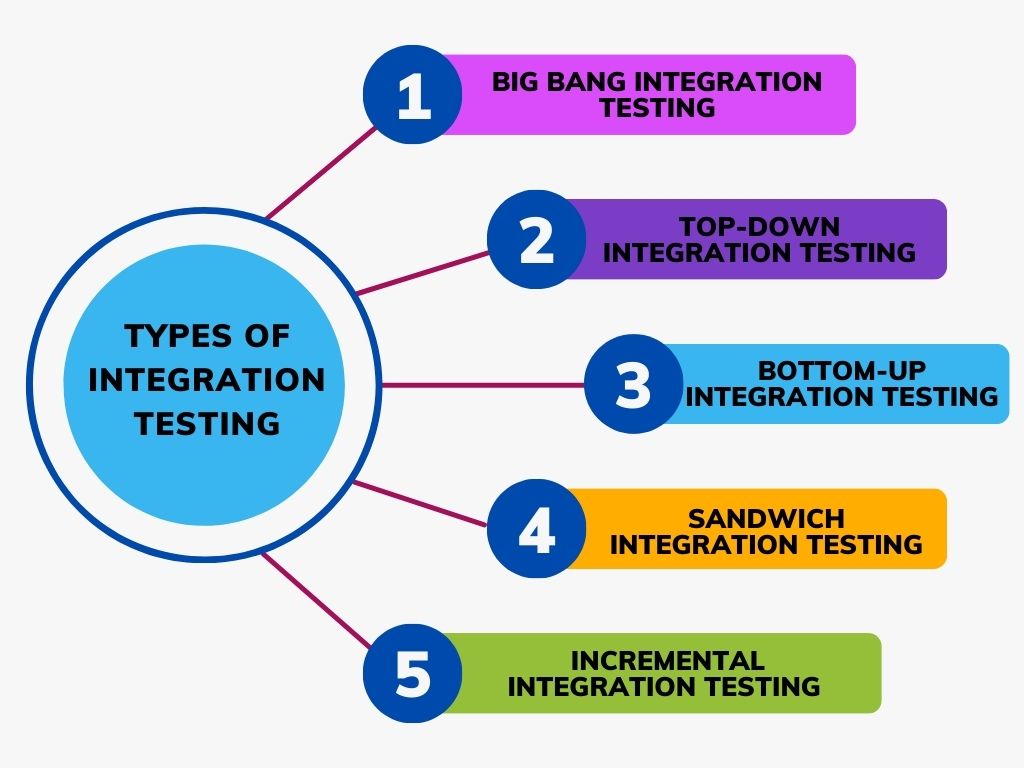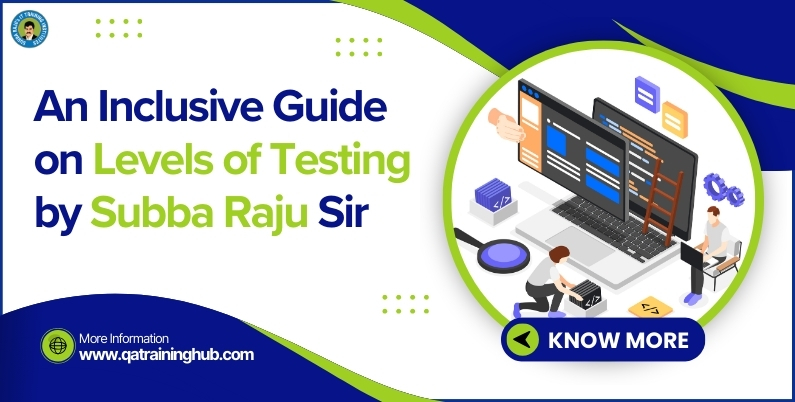A complete guide on Integration testing by Subba Raju Sir Videos

Integration testing focuses on validating the interaction between individual components of a system to ensure they function cohesively as a unit. Integration testing by Subba Raju Sir’s videos are a valuable resource, offering in-depth explanations and practical insights into testing methodologies.
At QA Training Hub, we believe that learning from industry experts like Subba Raju Sir can greatly accelerate your journey in mastering complex testing techniques. In this guide, we’ll explore the objectives, types, tools, and steps involved in integration testing, with references to Subba Raju Sir’s videos that will enrich your understanding and application of these concepts.
In the world of software development, integration testing plays a crucial role in ensuring the smooth interaction between different modules or components of a system. By focusing on how these components work together, integration testing ensures that the software functions cohesively, reducing the risk of system failures after deployment.
For those interested in learning more about integration testing, QA training in Hyderabad by industry experts like Subba Raju Sir provides hands-on experience and expert guidance. Let’s dive deeper into integration testing, its objectives, types, tools, examples, and more.
Objectives of Integration Testing
The primary goal of integration testing is to identify issues in the interaction between integrated modules, such as:
- Ensuring proper data flow between modules.
- Detecting interface defects.
- Verifying that the modules work as intended when combined.
- Ensuring smooth interactions between software components and external systems (APIs, databases).
- Detecting performance bottlenecks in the integrated system.
Types of Integration Testing
There are several approaches to integration testing, each designed to suit specific needs based on system architecture and testing requirements. Understanding these types helps ensure that the modules interact seamlessly while minimizing potential integration issues.
1. Big Bang Integration Testing
In Big Bang Integration Testing, all the components or modules of a system are integrated at once and tested as a complete unit. While this approach can quickly expose major system-wide defects, it has significant drawbacks. Ideal for smaller systems where all components are ready for testing simultaneously. Reduces the time spent on creating and maintaining stubs or drivers. Identifying the root cause of a defect becomes challenging because all modules are integrated at once. High risk of missing critical bugs that only surface during gradual integration. Big Bang testing works best when all the modules are completed at the same time, but it is rarely used in complex systems due to its complexity in isolating bugs.
2. Top-Down Integration Testing
In Top-Down Integration Testing, testing begins from the higher-level modules and progresses towards the lower-level modules. This approach is particularly useful when testing the core functionality early in the process, allowing developers to focus on the main control flow. Major design flaws are identified early, reducing the cost of fixes later in the development cycle. Early prototype of the system can be created using high-level modules, giving a clear picture of how the final product will function. Requires the use of stubs to simulate lower-level modules that are not yet integrated, which may lead to incomplete testing. Delays testing of critical low-level modules until later in the process, which might lead to missing defects in those modules. Subba Raju Sir’s videos often emphasize the benefits of this approach in scenarios where control flow and critical business logic reside in higher-level modules, making it essential to test these areas first.

3. Bottom-Up Integration Testing
In Bottom-Up Integration Testing, testing begins from the lower-level modules, which are the building blocks of the system, and progresses upwards. This approach ensures that the foundational aspects of the system are thoroughly tested before moving to higher-level modules. Testing lower-level modules early helps identify defects in core functionality. Reduces the risk of missing bugs in the underlying code that could affect the higher-level modules. Requires the use of drivers to simulate higher-level modules, which may slow down the testing process. Integration of the entire system is delayed, as higher-level modules can only be tested once all lower-level modules are ready. Subba Raju Sir’s QA videos highlight how bottom-up integration testing is useful in scenarios where the system’s foundation needs thorough validation before building on top of it.
4. Sandwich (Hybrid) Integration Testing
Sandwich Integration Testing, also known as Hybrid Integration Testing, combines elements of both top-down and bottom-up approaches. In this method, both higher and lower-level modules are tested simultaneously. Middle-level modules are integrated and tested last, creating a balanced approach that tests critical areas of the system early on. Provides the benefits of both top-down and bottom-up testing by testing both control flow and data flow early. Identifies critical issues at various levels simultaneously, leading to faster defect identification and resolution. More complex and time-consuming to implement, as it requires both drivers and stubs. Testing can become complicated due to the simultaneous focus on multiple levels of the system. This approach works well in large and complex systems where both the structure and the core logic need to be validated early. Subba Raju Sir’s tutorials often recommend hybrid testing when dealing with enterprise-level applications that require testing across various tiers simultaneously.
5. Incremental Integration Testing
Incremental Integration Testing is a structured approach where modules are integrated and tested one by one. It can be executed using either a Top-Down or Bottom-Up method, depending on the system design. Makes it easier to pinpoint the source of any defects, as only one module is added and tested at a time. Allows for thorough testing and validation at every stage of integration. Can be time-consuming, as each module needs to be individually integrated and tested. Requires careful planning to ensure that all modules are tested in the correct sequence. This approach is especially useful in complex systems where each module plays a significant role in the overall system functionality. Incremental testing ensures that every module is working correctly before progressing further. Subba Raju Sir’s videos provide excellent demonstrations of each of these integration testing types, offering practical examples and scenarios to better understand when to use each approach. By applying these methods, software testers can ensure that all integrated modules perform optimally, resulting in a stable and reliable system.
Tools for Integration Testing
Various tools help in automating and streamlining the integration testing process. Some widely used integration testing tools include:
- JUnit
A popular unit testing framework for Java, it can also be used for integration testing by grouping multiple test cases. - Selenium
While primarily used for UI testing, Selenium can be utilized for integration testing, particularly when testing web-based applications. - Postman
A powerful tool for testing APIs, Postman is widely used in integration testing to ensure APIs function correctly with the application. - TestNG
A testing framework inspired by JUnit and NUnit, TestNG is highly effective for running integration tests, especially when multiple modules are involved. - SoapUI
This tool is commonly used for testing web services and APIs, making it an excellent choice for integration testing of applications that rely on these technologies.
Integration Testing Steps
Performing integration testing involves the following steps:
- Identify Modules for Testing
Begin by identifying which modules or components need to be integrated and tested together. - Define Test Scenarios
Create test cases that simulate real-world scenarios to validate the interaction between integrated modules. - Set Up the Test Environment
Prepare the environment with the necessary tools, databases, and interfaces required for testing. - Run the Tests
Execute the test cases and monitor the interactions between the modules to ensure they function as expected. - Analyze Results
Analyze the test results to identify any defects or inconsistencies in module interactions. - Report and Fix Bugs
Document any identified issues and collaborate with the development team to resolve them.
Levels of Integration Testing
Integration testing can be executed at different levels depending on the system’s architecture and complexity:
- Component Integration Testing
Involves testing individual software components that have been integrated to ensure they work together as expected. - System Integration Testing
Tests the interaction between the entire system’s components, including hardware and external systems, to ensure seamless functionality. - Interface Testing
Focuses on verifying that the interfaces between various components function correctly, ensuring that data is passed between modules in the correct format.
Examples of Integration Testing
- E-commerce Application
When adding a payment gateway to an e-commerce application, integration testing ensures that the gateway works seamlessly with the cart and checkout modules. - Banking Software
Integration testing would check the interaction between the customer management module and the transaction processing system to ensure accuracy in data flow. - API Integration
For applications dependent on third-party APIs, integration testing validates that these APIs interact smoothly with the core application, ensuring data exchange is accurate.
Conclusion
Integration testing by Subba Raju Sir’s videos is an essential phase in the software development lifecycle, ensuring that individual modules work cohesively as a unified system. By identifying defects in the interactions between modules, integration testing prevents larger system failures, enhances software quality, and improves user satisfaction.
Each approach to integration testing—whether it’s Big Bang, Top-Down, Bottom-Up, or Hybrid—has its own advantages and specific use cases. Choosing the right method depends on the complexity of the system, the development timeline, and the criticality of various modules. Additionally, using effective integration testing tools like JUnit, Selenium, and Postman helps streamline the process and provides better test coverage.
Learning and mastering integration testing is crucial for quality assurance professionals aiming to deliver robust software systems. With practical examples and hands-on guidance, QA training in Hyderabad by Subba Raju Sir is an excellent resource for both beginners and seasoned professionals looking to enhance their skills. Integration testing by Subba Raju Sir’s videos provide clear, in-depth tutorials on integration testing techniques, offering insights that can be immediately applied to real-world projects.
For a deeper understanding of integration testing and to explore other QA methodologies, visit QA Training Hub, where Subba Raju Sir’s QA videos will guide you through mastering the entire software testing lifecycle. Whether you’re aiming to become proficient in integration testing or seeking to enhance your overall QA skills, these resources are designed to help you achieve your career goals.







